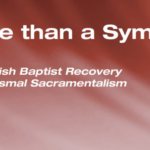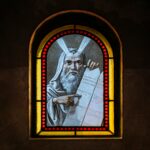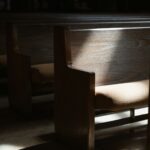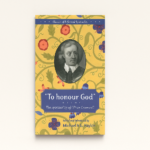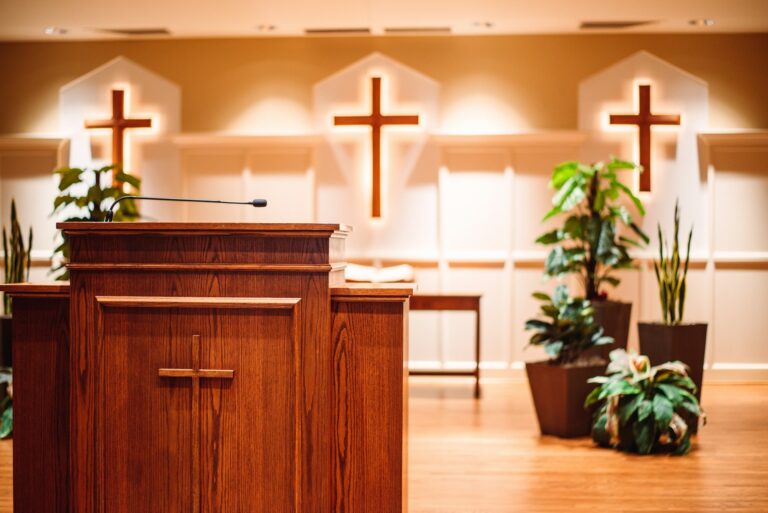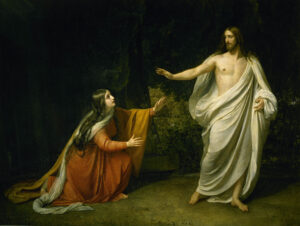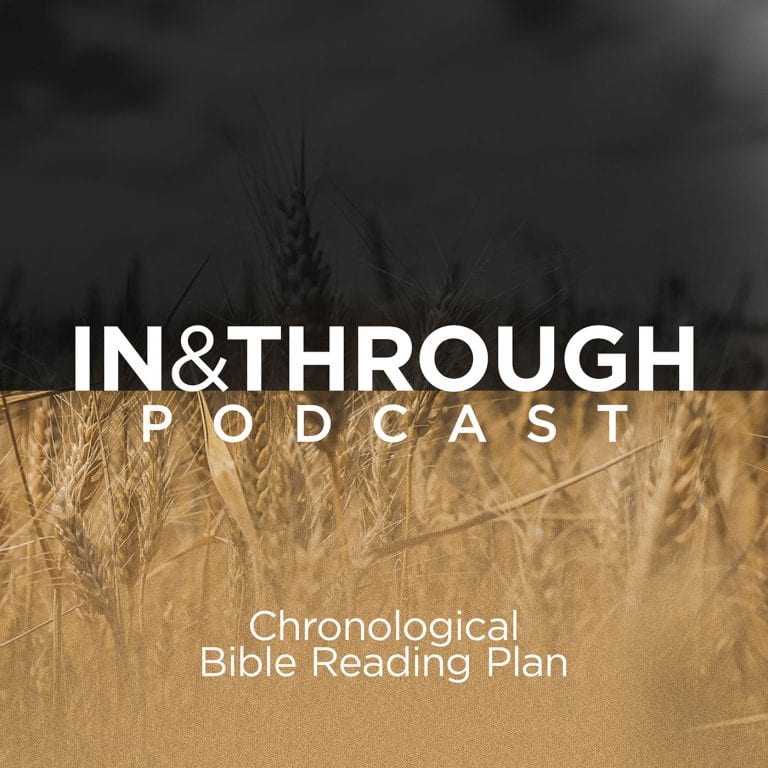Penal substitution means our sin is imputed to Jesus as he bears the just God’s wrath, while Jesus’s righteousness is imputed to us so that God declares us justified. We have a real guilt before God that requires a legal pardon to be justified. Jesus is crucified as our substitute and suffers our punishment and now; clothed in his righteousness, God declares us righteous.
Penal substitution is not an exhaustive view of the atonement, but it is essential to understanding our salvation, and Mark’s account of the crucifixion helps us understand why.
Jesus Our Substitute
Substitution is central to atonement in the Old Testament. For example, in Leviticus 16, on the day of Atonement, Aaron was to take the scapegoat “lay both his hands on the head of the live goat and confess over it all the Israelites’ iniquities and rebellious acts—all their sins. He is to put them on the goat’s head and send it away into the wilderness by the man appointed for the task. The goat will carry all their iniquities into a desolate land, and the man will release it there” (Lev 16:22-23). The sin of the people was born and carried away by a substitute.
In Mark’s account of the crucifixion, Jesus takes the place of the Lamb, who is the substitute for sinners.
In Mark 15:1-5, Pilate questions Jesus, and the Sanhedrin hurls accusations at him, but he “still did not answer.” He is silent in the face of his accusers. Attentive Bible readers will notice Mark’s allusion to Isaiah 53:7, “Like a lamb led to the slaughter and like a sheep silent before her shearers, he did not open his mouth.” Jesus’s silence is symbolic of his innocence. A few verses later, he is sentenced to die by crucifixion, but, as Mark shows in these early verses, not for any crime of his own. He is there in place of us.
In 15:6-15, Pilate offers an exchange -either Jesus or Barabbas, the insurrectionist, will die. Barabbas was “in prison with rebels who had committed murder during the rebellion” (Mk 15:8). The charge against Jesus given to Pilate was that Jesus, by declaring himself King of the Jews, was opposing Caesar. They accused Jesus of rebellion against Rome, the very crime Barabbas is guilty of. Pilate then sentences Jesus to be crucified, the punishment Rome inflicted on insurrectionists like Barabbas.
They chose Barabbas to be freed and cried for Jesus to be crucified.
Jesus is exchanged for a criminal and bears the penalty of Barabbas’s crime. Barabbas is freed because Jesus is crucified.
Mark recounts this scene not simply as historical information but because it vividly portrays the purpose of the cross. Through Isaiah, God foretold the Messiah would be silent before his accusers, counted among criminals, and would bear the punishment of our rebellion (Isa 53:7-12). Jesus is silent before the Sanhedrin and Pilate, he is counted among the rebels in Barabbas’s place, and he bears the punishment for Barabbas’s rebellion.
In Mark’s account, Jesus is our substitutionary Lamb.
Jesus Bearing Our Punishment
We’ve seen how Mark’s record of the crucifixion highlights the substitutionary nature of the cross. But was it penal? Was Jesus’s substitution for the purpose of satisfying God’s justice by being punished in our place and for our sins?
There are clues in the text that reveal Mark’s theological framework of the cross includes penal substitution.
First, as we’ve already noted, Jesus is not simply exchanged for Barabbas but suffers the penalty Barabbas would’ve received.
Second, Mark draws attention to the darkness that descends around the cross, ” When it was noon, darkness came over the whole land until three in the afternoon” (Mk 15:33). This was not the regular darkness of nighttime, but a unique darkness, a divine darkness.
Darkness is often symbolic of God’s judgment. God brought darkness over Egypt. When describing the day of God’s judgment Amos 8:9 says, “And in that day— this is the declaration of the Lord God— I will make the sun go down at noon; I will darken the land in the daytime.” Zephaniah describes the day of wrath as “a day of darkness and gloom” (Zeph 1:15). This darkness is the judgment of God.
God’s judgment was present, but where was it directed? Was the judgment directed at those who crucified Jesus? Or was this judgment born by the one hanging on the cross?
This leads to the third clue, Jesus’s God-forsaken cry from the cross. “And at three Jesus cried out with a loud voice, ‘Eloi, Eloi, lemá sabachtháni?’ which is translated, ‘My God, my God, why have you abandoned me?’” (Mk 15:34). Jesus appropriates the words of David from Psalm 22. Why? New Testament scholar, James Edwards, vividly explains, “Rejected and scorned by Israel, sacrificed as a political pawn by Rome, denied and abandoned by his own followers, Jesus is wholly forsaken and exposed to the horror of humanity’s sin. Its horror is so total that in his dying breath he senses his separation from God.”[i] As the substitute for sinners, Jesus, in his human nature, tastes the God-forsakenness of sins penalty. The darkness of God’s judgment is aimed at Jesus on the cross.
Separation from God is punishment for sin. Adam and Eve were driven from the Garden of God’s presence, Israel was exiled from the land of God’s promise, and Ezekiel saw the glory of God abandon the Jerusalem Temple, as a penalty for sin. Jesus’s cry from the cross is the cry of the one who bears this penalty in our place. We are forgiven because he was forsaken in our place.
However, this must not be misunderstood as though, at that moment, the Father turns with hatred from Jesus. At key points in Mark, the Father speaks of his delight in Jesus and in his giving himself as a ransom for many (1:11, 9:7). Jesus’ prayer in the garden “Abba, Father! All things are possible for you. Take this cup away from me. Nevertheless, not what I will, but what you will” (14:36) reveals that the Father and Son are in lockstep. Jesus fulfills God’s plan of redemption by taking the curse of sin upon himself. The Father delights in the Son’s sacrifice for sinners.
The fourth clue, Mark’s description of the curtain being torn, reveals what Jesus’s crucifixion accomplished. “Jesus let out a loud cry and breathed his last. Then the curtain of the temple was torn in two from top to bottom” (Mark 15:37-38). The death of Jesus tore the curtain separating the people from the Holy of Holies, the place of God’s presence, in the Temple. Since it was torn from the top, it shows us that God is the one doing the tearing.
The meaning of this is profound. By tearing the curtain, God closes the book on the sacrificial system. The blood of bulls and goats that was necessary for him to be present among sinners is now obsolete because Jesus “entered the most holy place once for all time, not by the blood of goats and calves, but by his own blood, having obtained eternal redemption” (Heb 9:12). Jesus’s sacrifice secured an eternal redemption, the torn curtain will never be stitched back together.
The connection between Jesus’s death and the tearing of the curtain means God is reconciled to sinners. The Holy of Holies is no longer restricted to the High Priest, once a year, only after making a sacrifice for his sin, but now, God dwells with people of all nations through Jesus Christ.
Mark’s account of Jesus’s crucifixion helps us see the contours of penal substitution and its purpose. He shows Jesus dying in the place of sinners (substitution), bearing the sinner’s punishment (penal), and tearing the curtain of separation between God and us.
Penal substitution matters because God does not simply sweep our sin aside, and we can’t do anything to erase the debt of our sins. Because God is just, He will not let the wicked go unpunished. Because God is merciful, Christ bore our punishment and reconciled us to God.
Since our sin was punished in Christ, God will not again punish us for it. Calvin says, “if we are delivered from guilt through Christ, the penalties that arise from it must cease.”[ii] God will discipline believers and furnish their faith through trials, but the darkness of divine wrath will not descend on those who are in Christ.
[i] James R. Edwards, The Gospel according to Mark, The Pillar New Testament Commentary (Grand Rapids, MI; Leicester, England: Eerdmans; Apollos, 2002), 476.
[ii] John Calvin, Institutes of the Christian Religion & 2, ed. John T. McNeill, trans. Ford Lewis Battles, vol. 1, The Library of Christian Classics (Louisville, KY: Westminster John Knox Press, 2011), 658.







